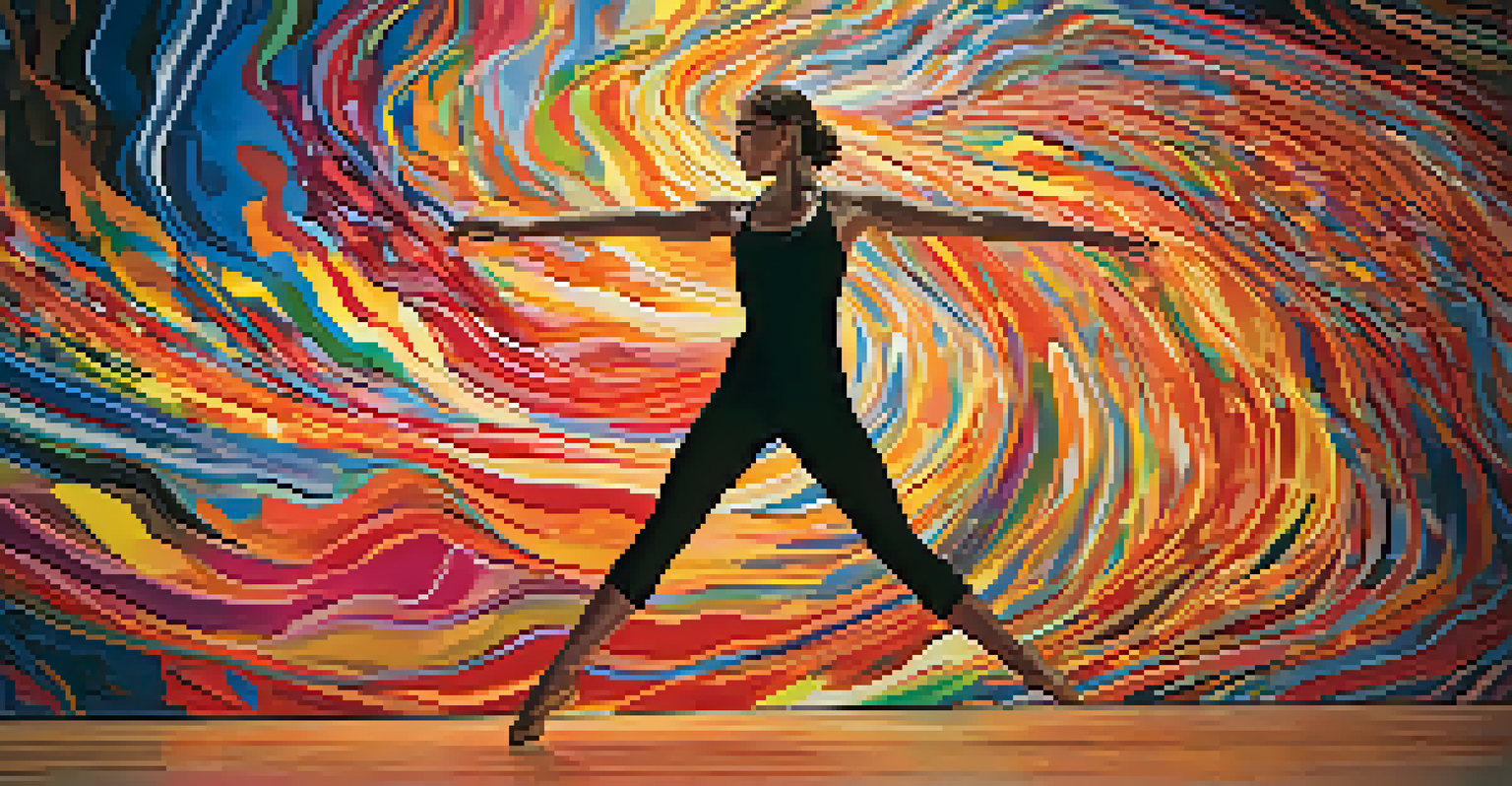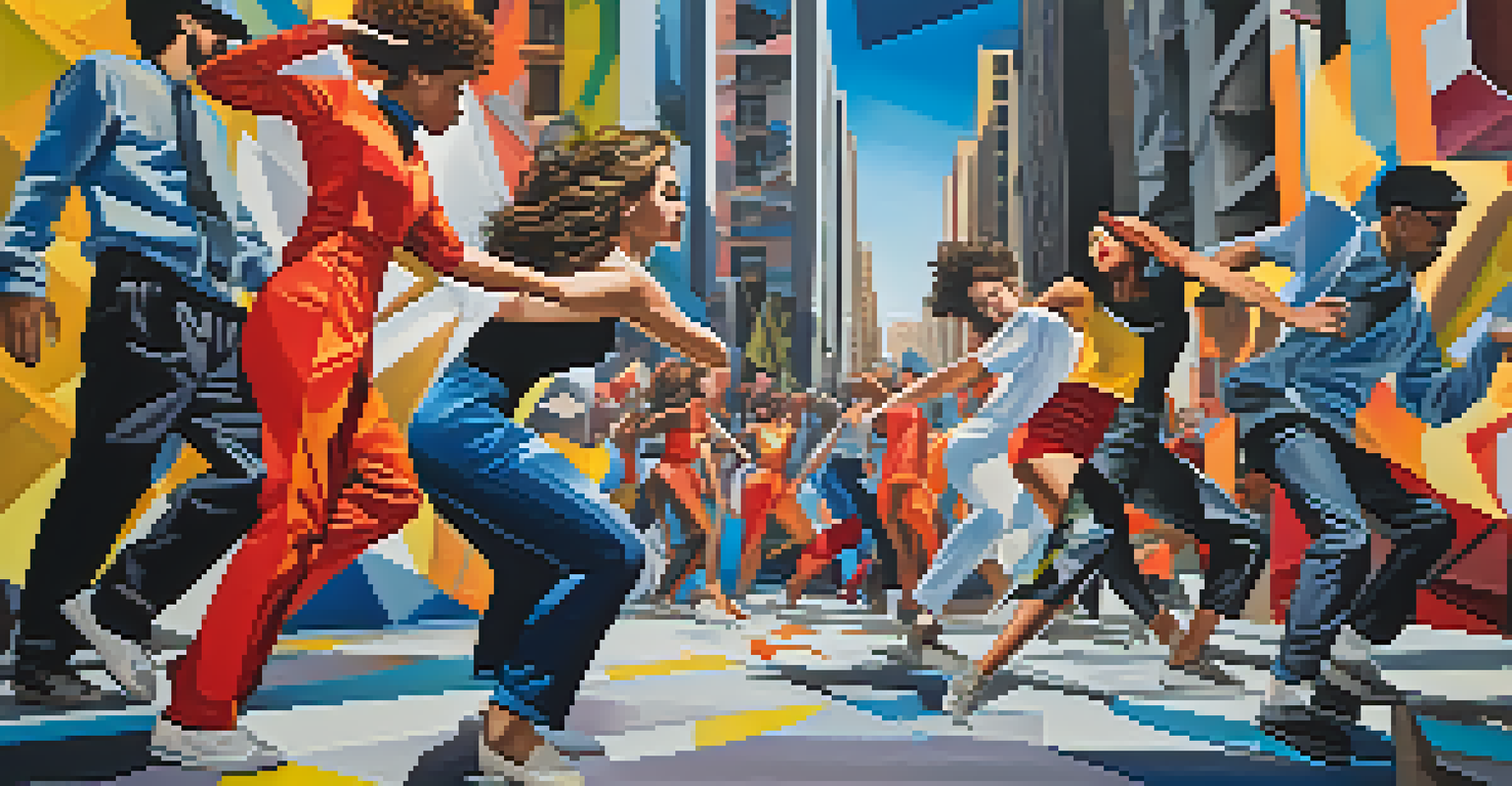The Body as Canvas: Dance Movements Inspired by Visual Art

The Intersection of Dance and Visual Art
Dance and visual art have long shared a creative bond, each influencing the other in profound ways. When dancers move, they often evoke images and emotions that can be reminiscent of paintings or sculptures. This synergy allows performers to explore new dimensions of expression, turning their bodies into living canvases.
Dance is the hidden language of the soul.
For instance, a dancer inspired by Van Gogh's swirling skies may incorporate fluid, sweeping movements that mimic the energy of his brush strokes. Similarly, the sharp angles found in Cubist art can lead to choreography that embraces geometric precision. Such collaborations often result in performances that are both visually striking and emotionally resonant.
By blending these two art forms, artists invite audiences to experience dance not just as a sequence of movements but as a visual narrative. This unique fusion encourages viewers to see dance through the lens of art, transforming the stage into a gallery of human expression.
Historical Inspirations: Dance Meets Famous Artworks
Throughout history, many choreographers have drawn inspiration from iconic artworks to shape their performances. For example, Martha Graham's 'Night Journey' was influenced by the Greek myth of Oedipus, which is also a theme explored in various visual arts. This interplay highlights how visual narratives can breathe life into dance movements.

Another remarkable instance is the work of choreographer Merce Cunningham, who often collaborated with visual artists like Robert Rauschenberg. Their joint creations blurred the lines between dance and visual art, resulting in performances that were as much about the experience as the story being told. These innovative approaches opened new pathways for dancers to convey complex themes and emotions.
Dance and Art: A Creative Bond
Dance and visual art influence each other, creating immersive performances that transform movement into visual storytelling.
By revisiting these historical connections, contemporary dancers can reinvigorate their craft, finding fresh ways to interpret classic pieces while infusing them with modern sensibilities. This ongoing dialogue between dance and art ensures that both forms continue to evolve and inspire.
Contemporary Artists Blending Dance and Visual Art
In today's world, many contemporary artists are seamlessly blending dance with visual art, creating immersive experiences for audiences. Take, for example, the work of choreographer Akram Khan, whose performances often incorporate visual elements such as stunning projections and striking set designs. This multi-sensory approach captivates viewers and deepens their emotional engagement with the performance.
Art is the most beautiful of all lies.
Additionally, artists like Anna Halprin have used dance as a form of social commentary, often inspired by visual art's ability to convey powerful messages. By integrating their movements with thought-provoking imagery, these artists invite audiences to reflect on societal issues while enjoying the beauty of dance. The result is a compelling dialogue that transcends traditional boundaries.
This contemporary fusion not only showcases the versatility of dance but also emphasizes the importance of collaboration across artistic disciplines. As these artists continue to push creative limits, they inspire future generations to explore the vast possibilities when dance meets visual art.
Nature as a Canvas: Dance Inspired by the Environment
Nature serves as an endless source of inspiration for both visual artists and dancers alike. Choreographers often draw from the organic movements found in nature, translating them into fluid dance sequences that mimic the wind, water, or the growth of plants. This connection to the natural world encourages both the dancer and the audience to appreciate the beauty and intricacies of our environment.
For example, the choreography in works like 'The River' by choreographer Doris Humphrey uses flowing movements to evoke the gentle currents of water. Such performances remind viewers of the delicate interplay between humans and nature, highlighting the importance of environmental conservation. These experiences become a celebration of life, urging audiences to reconnect with the world around them.
Historical Inspirations in Dance
Choreographers often draw from iconic artworks, blending narratives that breathe life into dance and enrich the audience's experience.
By using nature as a canvas, dancers create a visceral experience that resonates deeply with viewers. This not only showcases the artistry of movement but also underscores a shared responsibility to protect and cherish our planet.
The Role of Color and Texture in Dance Choreography
Color and texture play crucial roles in both visual art and dance, influencing how performances are perceived by audiences. Choreographers often select costumes and set designs that reflect the mood or theme of their work, enhancing the overall experience. This attention to detail allows for a richer interpretation of the dance, engaging viewers on multiple sensory levels.
For instance, a performance inspired by a vibrant painting may feature bright, bold costumes that echo the color palette of the artwork. In contrast, a darker, more somber piece might incorporate muted tones and heavy fabrics to create a sense of weight and emotion. These choices not only enhance the visual appeal but also deepen the audience's emotional connection to the performance.
Ultimately, the interplay of color and texture in dance choreography serves to create a cohesive narrative that resonates with viewers. By carefully considering these elements, artists ensure that their performances are not just seen but felt, inviting audiences into an immersive world of creativity.
Audience Engagement: The Power of Experiential Art
In recent years, audience engagement has become increasingly important in performance art, with many artists seeking to involve viewers in the experience. This trend often manifests in performances that invite spectators to interact with the dancers or the visual elements of the show. Such immersive experiences can transform passive observers into active participants, deepening their connection to the art.
For example, some contemporary dance performances feature audience members moving through the space alongside dancers, allowing them to witness the choreography up close. This unique approach blurs the lines between performer and spectator, creating a shared experience that fosters a sense of community. As a result, viewers may leave the performance feeling inspired and energized.
Future of Art Collaborations
Advancements in technology promise exciting new ways for dance and visual art to merge, enhancing audience engagement and creativity.
By actively engaging audiences, artists can cultivate a deeper appreciation for the interplay between dance and visual art. This shift not only enhances the experience but also encourages a more profound understanding of the creative process behind these art forms.
The Future of Dance and Visual Art Collaborations
As we look to the future, the collaboration between dance and visual art shows no signs of slowing down. With advances in technology, artists have even more tools at their disposal to create innovative performances that challenge traditional boundaries. Virtual reality, interactive installations, and digital projections are just a few examples of how these two art forms can merge in exciting new ways.
Imagine a performance where dancers move within a digitally created landscape, with visuals that shift in real-time based on their movements. This level of interactivity not only captivates audiences but also allows for a personalized experience that highlights the unique relationship between dance and visual art. Such innovative creations promise to redefine how we perceive and engage with both forms.

As artists continue to push the envelope, we can expect to see more groundbreaking collaborations that celebrate the rich history of dance and visual art while embracing the future. This ongoing evolution ensures that both art forms remain relevant and inspiring, inviting new generations to explore their creative potential.